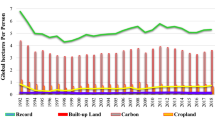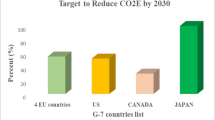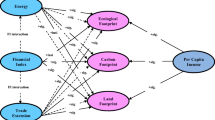Abstract
Oman is committed to turning carbon neutral by 2040 whereby identifying the environmental sustainability-stimulating factors has become a critically important agenda for the nation. Against this backdrop, this study attempts to evaluate the marginal effects of economic growth, financial development, and low-carbon energy use on Oman’s carbon footprint levels using quarterly frequency data spanning from 1984Q1 to 2018Q4. Controlling for structural break concerns in the data, the results from the empirical analysis verify the carbon footprint-related environmental Kuznets curve hypothesis for Oman in the long-run. In this regard, the threshold level of per capita real GDP level of Oman is predicted at around US $23,500 which is below the average and maximum per capita real GDP level of Oman during the period considered in this study. Besides, the development of the financial sector and scaling up consumption of low-carbon energy resources are evidenced to boost and curb Oman’s short- and long-run carbon footprint figures, respectively. More importantly, the joint carbon footprint-mitigating impact of financial development and low-carbon energy use is also unearthed from the findings. In line with these major findings, a couple of relevant policy interventions are suggested to help Oman accomplish its 2040 carbon-neutrality agenda.


Similar content being viewed by others
References
Abdouli M, Hammami S (2020) Economic growth, environment, fdi inflows, and financial development in Middle East countries: fresh evidence from simultaneous equation models. J Knowl Econ 11(2):479–511
Alsamara M, Mrabet Z, Saleh AS, Anwar S (2018) The environmental Kuznets curve relationship: a case study of the Gulf Cooperation Council region. Environ Sci Pollut Res 25(33):33183–33195
Aluko OA, Obalade AA (2020) Financial development and environmental quality in sub-Saharan Africa: is there a technology effect? Sci Total Environ 747:141515
Ardakani MK, Seyedaliakbar SM (2019) Impact of energy consumption and economic growth on CO2 emission using multivariate regression. Energy Strat Rev 26:100428
Awan A, Abbasi KR, Rej S, Bandyopadhyay A, Lv K (2022) The impact of renewable energy, internet use and foreign direct investment on carbon dioxide emissions: a method of moments quantile analysis. Renew Energy 189:454–466
Balsalobre-Lorente D, Driha OM, Leitão NC, Murshed M (2021) The carbon dioxide neutralizing effect of energy innovation on international tourism in EU-5 countries under the prism of the EKC hypothesis. J Environ Manag 298:113513
Balsalobre-Lorente D, Ibáñez-Luzón L, Usman M, Shahbaz M (2022) The environmental Kuznets curve, based on the economic complexity, and the pollution haven hypothesis in PIIGS countries. Renew Energy 185:1441–1455
Bandyopadhyay A, Rej S (2021) Can nuclear energy fuel an environmentally sustainable economic growth? Revisiting the EKC hypothesis for India. Environ Sci Pollut Res 28(44):63065–63086
Bello MO, Solarin SA, Yen YY (2018) The impact of electricity consumption on CO2 emission, carbon footprint, water footprint and ecological footprint: the role of hydropower in an emerging economy. J Environ Manag 219:218–230
Danish UR, Khan SUD (2020) Determinants of the ecological footprint: role of renewable energy, natural resources, and urbanization. Sustain Cities Soc 54:101996
Destek MA, Sinha A (2020) Renewable, non-renewable energy consumption, economic growth, trade openness and ecological footprint: evidence from organisation for economic Co-operation and development countries. J Clean Prod 242:118537
Destek MA, Ulucak R, Dogan E (2018) Analyzing the environmental Kuznets curve for the EU countries: the role of ecological footprint. Environ Sci Pollut Res 25(29):29387–29396
Dogan E, Ozturk I (2017) The influence of renewable and non-renewable energy consumption and real income on CO2 emissions in the USA: evidence from structural break tests. Environ Sci Pollut Res 24(11):10846–10854
Elshimy M, El-Aasar KM (2020) Carbon footprint, renewable energy, non-renewable energy, and livestock: testing the environmental Kuznets curve hypothesis for the Arab world. Environ Dev Sustain 22(7):6985–7012
Erdoğan S, Yıldırım DÇ, Gedikli A (2020) Natural resource abundance, financial development and economic growth: an investigation on Next-11 countries. Res Policy 65:101559
GCA. (2022). Global Carbon Atlas. Available at http://www.globalcarbonatlas.org/en/CO2-emissions (accessed on 20.5.2022)
GFN. (2022). Global Footprint Network. Avialable at https://www.footprintnetwork.org/resources/glossary/ (accessed on 20.5.2022)
Gregory AW, Hansen BE (1996) Practitioners corner: tests for cointegration in models with regime and trend shifts. Oxf Bull Econ Stat 58(3):555–560
Grossman GM, Krueger AB (1995) Economic growth and the environment*. Q J Econ 110:353–377. https://doi.org/10.2307/2118443
Grossman G, Krueger AB (1991) Environmental impacts of a North American free trade agreement (No. 644). CEPR Discussion Papers
Hamid I, Alam MS, Murshed M, Jena PK, Sha N, Alam MN (2022) The roles of foreign direct investments, economic growth, and capital investments in decarbonizing the economy of Oman. Environ Sci Pollut Res 29(15):22122–22138
Jahanger A, Usman M, Murshed M, Mahmood H, Balsalobre-Lorente D (2022) The linkages between natural resources, human capital, globalization, economic growth, financial development, and ecological footprint: the moderating role of technological innovations. Res Policy 76:102569
Jiang T, Yu Y, Jahanger A, Balsalobre-Lorente D (2022) Structural emissions reduction of China's power and heating industry under the goal of “double carbon”: a perspective from input-output analysis. Sustain Prod Cons 31:346–356
Khan M, Ozturk I (2021) Examining the direct and indirect effects of financial development on CO2 emissions for 88 developing countries. J Environ Manag 293:112812
Khan S, Murshed M, Ozturk I, Khudoykulov K (2022a) The roles of energy efficiency improvement, renewable electricity production, and financial inclusion in stimulating environmental sustainability in the Next Eleven countries. Renewable Energy
Khan Y, Oubaih H, Elgourrami FZ (2022b) The role of private investment in ICT on carbon dioxide emissions (CO2) mitigation: do renewable energy and political risk matter in Morocco? Environ Sci Pollut Res. https://doi.org/10.1007/s11356-022-19455-w
Khezri M, Karimi MS, Khan YA, Abbas SZ (2021) The spillover of financial development on CO2 emission: a spatial econometric analysis of Asia-Pacific countries. Renew Sust Energ Rev 145:111110
Kirikkaleli D, Güngör H, Adebayo TS (2022) Consumption-based carbon emissions, renewable energy consumption, financial development and economic growth in Chile. Bus Strateg Environ 31(3):1123–1137
Lee J, Strazicich MC (2004) Minimum LM unit root test with one structural break. Manu Dep Econ Appalachian State Univ 33(4):2483–2492
Mahmood, H. (2022). The effects of natural gas and oil consumption on CO2 emissions in GCC countries: asymmetry analysis. Environ Sci Pollut Res. https://doi.org/10.1007/s11356-022-19851-2
Mahmood H, Furqan M (2021) Oil rents and greenhouse gas emissions: spatial analysis of Gulf Cooperation Council countries. Environ Dev Sustain 23(4):6215–6233
Manzoor F, Wei L, Siraj M (2021) Small and medium-sized enterprises and economic growth in Pakistan: An ARDL bounds cointegration approach. Heliyon 7(2):e06340
Mehmood U (2022a) Examining the role of financial inclusion towards CO2 emissions: presenting the role of renewable energy and globalization in the context of EKC. Environ Sci Pollut Res 29(11):15946–15954
Mehmood U (2022b) Examining the role of financial inclusion towards CO2 emissions: presenting the role of renewable energy and globalization in the context of EKC. Environ Sci Pollut Res 29(11):15946–15954
Mehmood U (2022c) Environmental degradation and financial development: do institutional quality and human capital make a difference in G11 nations? Environ Sci Pollut Res. https://doi.org/10.1007/s11356-022-18825-8
Minlah MK, Zhang X (2021) Testing for the existence of the environmental Kuznets curve (EKC) for CO2 emissions in Ghana: evidence from the bootstrap rolling window Granger causality test. Environ Sci Pollut Res 28(2):2119–2131
Murshed, M., Nurmakhanova, M., Al-Tal, R., Mahmood, H., Elheddad, M., & Ahmed, R. (2022). Can intra-regional trade, renewable energy use, foreign direct investments, and economic growth mitigate ecological footprints in South Asia?. Energy Sources, Part B: Economics, Planning, and Policy. https://doi.org/10.1080/15567249.2022.2038730
Omri A, Daly S, Rault C, Chaibi A (2015) Financial development, environmental quality, trade and economic growth: what causes what in MENA countries. Energy Econ 48:242–252
Pesaran MH, Shin Y, Smith RJ (2001) Bounds testing approaches to the analysis of level relationships. J Appl Econ 16:289–326. https://doi.org/10.1002/jae.616
Salahuddin M, Gow J, Ozturk I (2015) Is the long-run relationship between economic growth, electricity consumption, carbon dioxide emissions and financial development in Gulf Cooperation Council Countries robust? Renew Sust Energ Rev 51:317–326
Saqib N (2022a) Nexus between the renewable and nonrenewable energy consumption and carbon footprints: evidence from Asian emerging economies. Environ Sci Pollut Res. https://doi.org/10.1007/s11356-022-19948-8
Saqib N (2022b) Green energy non-renewable energy financial development and economic growth with carbon footprint: heterogeneous panel evidence from cross-country. Economic Research-Ekonomska Istraživanja. https://doi.org/10.1080/1331677X.2022.2054454
Sarkodie SA (2021) Environmental performance, biocapacity, carbon & ecological footprint of nations: drivers, trends and mitigation options. Sci Total Environ 751:141912
Selcuk M, Gormus S, Guven M (2021) Do agriculture activities matter for environmental Kuznets curve in the Next Eleven countries? Environ Sci Pollut Res 28(39):55623–55633
Shahbaz M, Balcilar M, Mahalik MK, Akadiri SS (2021) Is causality between globalization and energy consumption bidirectional or unidirectional in top and bottom globalized economies? Intl J Fin Econ. https://doi.org/10.1002/ijfe.2519
Shahzad SJH, Shahbaz M, Ferrer R, Kumar RR (2017) Tourism-led growth hypothesis in the top ten tourist destinations: New evidence using the quantile-on-quantile approach. Tour Manag 60:223–232
Sharma R, Sinha A, Kautish P (2021) Does renewable energy consumption reduce ecological footprint? Evidence from eight developing countries of Asia. J Clean Prod 285:124867
Sinha A, Sengupta T, Alvarado R (2020) Interplay between technological innovation and environmental quality: formulating the SDG policies for next 11 economies. J Clean Prod 242:118549
U.S. Energy Information Administration (2019) Country analysis executive summary:Oman
Usman M, Balsalobre-Lorente D, Jahanger A, Ahmad P (2022) Pollution concern during globalization mode in financially resource-rich countries: do financial development, natural resources, and renewable energy consumption matter? Renew Energy 183:90–102
Usman O, Rafindadi AA, Sarkodie SA (2021) Conflicts and ecological footprint in MENA countries: implications for sustainable terrestrial ecosystem. Environ Sci Pollut Res 28(42):59988–59999
Valadkhani A, Smyth R, Nguyen J (2019) Effects of primary energy consumption on CO2 emissions under optimal thresholds: evidence from sixty countries over the last half century. Energy Econ 80:680–690
Wang X (2021) Determinants of ecological and carbon footprints to assess the framework of environmental sustainability in BRICS countries: a panel ARDL and causality estimation model. Environ Res 197:111111
World Bank. (2022). World Development Indicators. Available at https://data.worldbank.org/country/OM (accessed on 20.5.2022)
Zhao J, Sinha A, Inuwa N, Wang Y, Murshed M, Abbasi KR (2022) Does structural transformation in economy impact inequality in renewable energy productivity? Implications for sustainable development. Renew Energy 189:853–864. https://doi.org/10.1016/j.renene.2022.05.065
Zivot E, Andrews DWK (2002) Further evidence on the great crash, the oil-price shock, and the unit-root hypothesis. J Bus Econ Stat 20(1):25–44
Zmami M, Ben-Salha O (2020) An empirical analysis of the determinants of CO2 emissions in GCC countries. Intl J Sustain Dev World Ecol 27(5):469–480
Data availability
The data sources are mentioned in the “Model, data, and methodology.”
Author information
Authors and Affiliations
Contributions
NA conceptualized, conducted the econometric analysis, and wrote the introduction. NIH analyzed the findings and conducted the literature review. SAJ conducted the literature review and reviewed the draft. MM conceptualized, wrote the original draft, conducted the econometric analysis, highlighted the policy implications, supervised the work, and revised the manuscript. HM wrote the introduction and concluding remarks. MSA wrote the original draft and compiled the overall manuscript.
Corresponding author
Ethics declarations
Ethics Approval
Not applicable.
Consent to participate
Not applicable.
Consent for publication
Not applicable.
Competing interests
The authors declare no competing interests.
Additional information
Responsible Editor: Philippe Garrigues
Publisher’s note
Springer Nature remains neutral with regard to jurisdictional claims in published maps and institutional affiliations.
Rights and permissions
About this article
Cite this article
Alam, N., Hashmi, N.I., Jamil, S.A. et al. The marginal effects of economic growth, financial development, and low-carbon energy use on carbon footprints in Oman: fresh evidence from autoregressive distributed lag model analysis. Environ Sci Pollut Res 29, 76432–76445 (2022). https://doi.org/10.1007/s11356-022-21211-z
Received:
Accepted:
Published:
Issue Date:
DOI: https://doi.org/10.1007/s11356-022-21211-z




